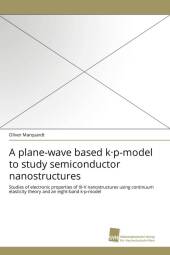 Neuerscheinungen 2010Stand: 2020-01-07 |
Schnellsuche
ISBN/Stichwort/Autor
|
Herderstra▀e 10
10625 Berlin
Tel.: 030 315 714 16
Fax 030 315 714 14
info@buchspektrum.de |

Oliver Marquardt
A plane-wave based k˙p-model to study semiconductor nanostructures
Studies of electronic properties of III-V nanostructures using continuum elasticity theory and an eight-band k˙p-model
2010. 160 S. 220 mm
Verlag/Jahr: S▄DWESTDEUTSCHER VERLAG F▄R HOCHSCHULSCHRIFTEN 2010
ISBN: 3-8381-1935-5 (3838119355)
Neue ISBN: 978-3-8381-1935-9 (9783838119359)
Preis und Lieferzeit: Bitte klicken
The eight-band k˙p-formalism in combination with the second-order continuum elasticity theory has been employed highly successful to understand the elastic and electronic properties of various semiconductor nanostructures like quantum dots, wires and wells. Within the present work, a novel, plane-wave formulation of these two continuum models is presented, which allows to employ these tools with a dramatically increased efficiency to a wide field of nanostructures and a large range of semiconductor materials. A correspondingly wide range of nanostructures that are promising for future application in quantum computing, quantum cryptography or novel light emitting devices, has been investigated in this work. These investigations allow to understand the properties of III-nitride quantum dots, wires and wells grown on polar and nonpolar surfaces that are promising candidates for novel light emitting devices.
The author finished his studies of Physics and Computer Scienceat the Humboldt-University, Berlin in 2005. He then worked as aresearcher at the Max-Planck-Institute for Iron and SteelResearch in Duesseldorf, and finished his PhD studies in 2010.Since Oct. 2010, the author works as a researcher at TyndallNational Institute in Cork, Ireland.


